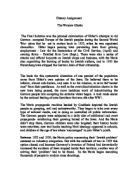However, no matter what fear and terror was in them, or what filth they lived in, there was still a determination inside the Jewish ghetto communities to maintain some sort of quality of life for themselves and their families. The Jewish council tried their best and endeavoured to manage the day to day management of the ghetto so that the shortages of food, along with the outbreak of disease, were dealt with in a structured and organized way. The council also, ‘ensured that the religious life of the people was maintained and that their talents and abilities continued to be developed for the benefit of all.’ (Susan Willoughby, The Holocaust 2002).
Those activities showed us that in a way there was a form of passive resistance in the face of Nazi anti-Semitism. Other types of resistance were also very existent in the ghetto, in the form of resistance groups, the most well known act of resistance and defiance in the Warsaw ghetto.
Photographs and video footage of the Holocaust often present us with alarming, sometimes scary, images of rows of victims standing submissively waiting to die. While this gives the impression of a meek and passive people who have abandoned all hope and their will to live, we must not make the mistake of assuming that the ghetto population lost their sense of self-respect or their will to survive. As Susan Willoughby states in The Holocaust, “on the contrary, in the ghettos ad the camps there was defiance and resistance which showed themselves in a variety of ways”.
Source A provides such film footage that would easily give you the impression that the Jewish peoples who have abandoned all hope and lost all will to live. Its shows us in a clear way of the atrocious living conditions within the Warsaw ghetto, highlighting the overcrowded and cold living quarters and the severity of the mistreatment, malnutrition, starvation, disease and death. The lack of heating is also portrayed in a good clear way, as the sources shows us people wrapped up in blankets, inside their dwellings, trying to keep warm. The images shown are very striking in terms of the enormous human suffering endured by the Jewish peoples within the ghetto, and it portrays an admirable dignity for the Jews in the face of atrocity.
Source D is an extract from Martin Gilbert’s Final Journey, it refers give us an insight into the overcrowded conditions. It revealed to us that the average of person to room was a huge thirteen, while thousands had no room at all. This source also highlights the shortage of heating fuel, with “718/780 dwellings having no heat at all”. Along with the severity of the Polish winter, the acute food shortage, and the fact that the Jews had no means of earning a living, the Nazi strategy, “ ensured tens of thousands of Jews died of starvation”, (Gilberts Final Journey).
However, Source D also reveals another side to the Jewish oppression within the ghetto. Gilbert reveals that, “despite this terrible oppression and isolation, the Jews of Warsaw struggled to maintain, amid the starvation and sickness, a decent, civilized way of life”. Gilbert states that a passive resistance was in operation, with the Jews actively promoting their pastimes and indeed their culture as, “illegal schools were organized and religious seminaries worked in secret”. Gilbert also refers to the operation of resistance groups, despite the fact that they had no weapons, and the publication of illegal magazines and pamphlets. This gives an insight to the will to survive and maintain self-respect that existed among the Jewish community in the face of extreme religious and cultural persecution.
Source E, which is an extract from Paul Hilberg’s The Destruction of European Jews, 1948, quoted in Gilbert’s Holocaust, also give us evidence and looks into social services that were in operation inside the ghetto. Hilberg states that, “there were occupational training programs, workshops, rationing systems, housing authorities, hospitals, ambulances and other services in the ghettos”. This group of services help us to appreciate the effort made by the Jewish community to provide a structure that attempted to deal with the health and social problems that the ghetto presented them. It also demonstrates the will of the Jewish community to carry on with life, no matter how miserable it had become under the Nazi occupation.
Overall, Source A provides video footage that shows us appalling conditions, starvation, disease and death. However, the video footage may give the watcher the impression that the Jewish people were submissive, without hope, self-respect, or having any will whatsoever to survive. Although, this source could also be interpreted as demonstrating the admirable sense of dignity while staring into the face of atrocity and persecution. Sources D and E provide evidence that the Jewish community were not submissive, and had managed to organise events, cultural groups, religious gatherings, and health and social service. These sources, along with the use of source A help give a more rounded up picture of the life and times inside the ghetto. Thus through the usage of source A, D and E we can draw a full and accurate picture of life in the Warsaw Ghetto. We can conclude that from the three sources we can interpret life in the ghetto as a life that maintained the will to survive, but the life showed us that the Jewish population had had an amazing sense of dignity while facing these terrible times, and facing the persecution of their religion and culture. Indeed the ghetto and the Final Solution was a persecution of their very right to live.







